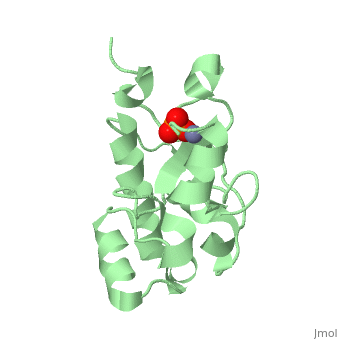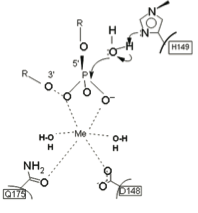H-N-H motif
From Proteopedia
| |||||||||
| 1fsj, resolution 1.80Å (default scene) | |||||||||
|---|---|---|---|---|---|---|---|---|---|
| Ligands: | PO4, ZN | ||||||||
| Activity: | Deoxyribonuclease I, with EC number 3.1.21.1 | ||||||||
| Related: | 1bxi, 1emv, 1fr2 | ||||||||
| |||||||||
| |||||||||
| Resources: | FirstGlance, OCA, PDBsum, RCSB | ||||||||
| Coordinates: | save as pdb, mmCIF, xml | ||||||||
The HNH motif is present in many enzymes, including many types of Colicin, such as Colicin E9. It is also at the catalytic centre of homing endonucleases. It adopts ββα-Me structure, where Me indicates the metal ion it binds to.
Proteins containing the HNH motif fall into the HNH superfamily. These include homing endonucleases, colicins, restriction endonucleases, transposases and DNA packaging factors[1]. The core of the HNH domain consists of two antiparallel β-strands connected with a loop of varying length, and flanked by an α-helix, with a metal (divalent cation[2]) binding site between the two. In colicins this motif exists independently as an independently folded catalytic domain[3]. The α helix is shown to be required for the stability of the complex formed when the enzyme binds to DNA, and without it activity is lost[4].
The HNH motif is commonly found throughout bacteria and fungi[5][6]. To date only one known vertebrate protein contains the HNH motif; annealing helicase 2 (AH2), which does not show any nuclease activity. It is hypothesised that the motif in AH2 either has a non-nuclease related function, or has latent activity activated under specific conditions[7].
Active site
The active sites of these nucleases are strongly conserved, and the ability to tolerate a mutation in the conserved catalytic site appears high in some studies of colicins resulting in measurable activity, but reports in other enzymes containing the motif show a loss of DNA cleavage activity[8]. The activity in the catalytic site is dependent on the presence of a neighbouring imidazole ring, and in the mutations this takes over as a (less efficient) general base for the reaction - usually carried out by the histadine general base. Restrictions on the alternative mutated pathways are probably due to steric contraints placed on the HNH motif, which is involved in protein folding, DNA binding and catalysis simultaneously[9].
The 3 conserved sites (HNH) are strongly structurally and mechanistically conserved across the diverse range of enzymes. The first histadine acts as the general base of the DNA cleavage reaction, and is present at the end of the first β-strand. The asparagine residue stabilises the position of the two β-strands relative to each other. This residue can be replaced by alternative residues that also act to structurally stabilise the position. The final residue is a metal binding histadine, which can be replaced sometimes with a second asparagine instead, creating a HNN motif that acts in the same way as HNH. This domain interacts mostly with the minor groove of the DNA it is targeting, contacting phosphate groups near the 3' hydroxyl of the scissile phosphate[10].
Catalytic mechanism
All studied mechanisms of action have resulted in the same proposed mechanism. The pKa of the histadine general base is elevated due to a nearby hydrogen bond. The imidazole ring, also close by, deprotonates a water molecule and positions it for an in-line nucleophilic attack on the phosphate in the backbone of DNA. A single metal ion bound in the active site stabilises this transition state, but does not participate in the attack[11]. The image shows how this mechanism looks[12].
References
- ↑ Cymerman IA, Obarska A, Skowronek KJ, Lubys A, Bujnicki JM. Identification of a new subfamily of HNH nucleases and experimental characterization of a representative member, HphI restriction endonuclease. Proteins. 2006 Dec 1;65(4):867-76. PMID:17029241 doi:10.1002/prot.21156
- ↑ Pingoud A, Fuxreiter M, Pingoud V, Wende W. Type II restriction endonucleases: structure and mechanism. Cell Mol Life Sci. 2005 Mar;62(6):685-707. PMID:15770420 doi:10.1007/s00018-004-4513-1
- ↑ Eastberg JH, Eklund J, Monnat R Jr, Stoddard BL. Mutability of an HNH nuclease imidazole general base and exchange of a deprotonation mechanism. Biochemistry. 2007 Jun 19;46(24):7215-25. Epub 2007 May 22. PMID:17516660 doi:10.1021/bi700418d
- ↑ Vasu K, Saravanan M, Bujnicki JM, Nagaraja V. Structural integrity of the beta beta alpha-Metal finger motif is required for DNA binding and stable protein-DNA complex formation in R.KpnI. Biochim Biophys Acta. 2008 Feb;1784(2):269-75. PMID:18329982
- ↑ Cymerman IA, Obarska A, Skowronek KJ, Lubys A, Bujnicki JM. Identification of a new subfamily of HNH nucleases and experimental characterization of a representative member, HphI restriction endonuclease. Proteins. 2006 Dec 1;65(4):867-76. PMID:17029241 doi:10.1002/prot.21156
- ↑ Huang H, Yuan HS. The conserved asparagine in the HNH motif serves an important structural role in metal finger endonucleases. J Mol Biol. 2007 May 4;368(3):812-21. Epub 2007 Feb 27. PMID:17368670 doi:10.1016/j.jmb.2007.02.044
- ↑ Yusufzai T, Kadonaga JT. Annealing helicase 2 (AH2), a DNA-rewinding motor with an HNH motif. Proc Natl Acad Sci U S A. 2010 Dec 7;107(49):20970-3. Epub 2010 Nov 15. PMID:21078962 doi:10.1073/pnas.1011196107
- ↑ Saravanan M, Bujnicki JM, Cymerman IA, Rao DN, Nagaraja V. Type II restriction endonuclease R.KpnI is a member of the HNH nuclease superfamily. Nucleic Acids Res. 2004 Nov 23;32(20):6129-35. Print 2004. PMID:15562004 doi:10.1093/nar/gkh951
- ↑ Eastberg JH, Eklund J, Monnat R Jr, Stoddard BL. Mutability of an HNH nuclease imidazole general base and exchange of a deprotonation mechanism. Biochemistry. 2007 Jun 19;46(24):7215-25. Epub 2007 May 22. PMID:17516660 doi:10.1021/bi700418d
- ↑ Flick KE, Jurica MS, Monnat RJ Jr, Stoddard BL. DNA binding and cleavage by the nuclear intron-encoded homing endonuclease I-PpoI. Nature. 1998 Jul 2;394(6688):96-101. PMID:9665136 doi:10.1038/27952
- ↑ Galburt EA, Chevalier B, Tang W, Jurica MS, Flick KE, Monnat RJ Jr, Stoddard BL. A novel endonuclease mechanism directly visualized for I-PpoI. Nat Struct Biol. 1999 Dec;6(12):1096-9. PMID:10581547 doi:10.1038/70027
- ↑ Vasu K, Saravanan M, Rajendra BV, Nagaraja V. Generation of a manganese specific restriction endonuclease with nicking activity. Biochemistry. 2010 Sep 28;49(38):8425-33. PMID:20734974 doi:10.1021/bi101035k



